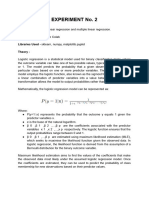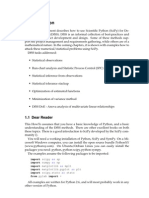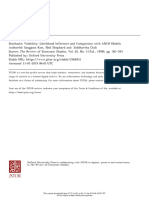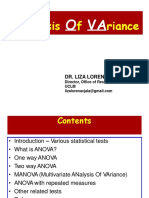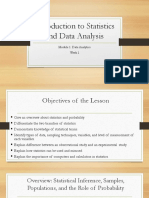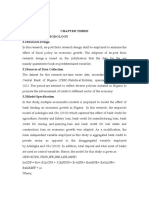Modeling The S&P 500 Index Using The Kalman Filter and The Laglasso
Modeling The S&P 500 Index Using The Kalman Filter and The Laglasso
Uploaded by
blumarin99Copyright:
Available Formats
Modeling The S&P 500 Index Using The Kalman Filter and The Laglasso
Modeling The S&P 500 Index Using The Kalman Filter and The Laglasso
Uploaded by
blumarin99Original Title
Copyright
Available Formats
Share this document
Did you find this document useful?
Is this content inappropriate?
Copyright:
Available Formats
Modeling The S&P 500 Index Using The Kalman Filter and The Laglasso
Modeling The S&P 500 Index Using The Kalman Filter and The Laglasso
Uploaded by
blumarin99Copyright:
Available Formats
Modeling the S&P 500 Index using the Kalman Filter and the LagLasso
Nicolas Mahler ENS Cachan & UniverSud CMLA UMR CNRS 8536 and Telecom Paristech (TSI) LTCI UMR Institut Telecom/CNRS 5141 nico.mahler@gmail.com
Abstract
This article introduces a method to predict upward and downward monthly variations of the S&P 500 index by using a pool of macro-economic and nancial explicative variables. The method is based on the combination of a denoising step, performed by Kalman ltering, with a variable selection step, performed by a Lasso-type procedure. In particular, we propose an implementation of the Lasso method called LagLasso which includes selection of lags for individual factors. We provide promising backtesting results of the prediction model based on a naive trading rule.
Introduction
We consider the problem of predicting monthly movements of the S&P 500 index, and assume that a small subset of macro-economic and nancial predictors can efciently represent the exogenous inuence on S&P 500. The inuence of each of these predictors can change over time and it can be lagged. Additionnally, according to economists (cf.[8]), S&P 500 is sensitive to the variations of those predictors around their own trend rather than to the variations themselves. Therefore, we need to ltrate the predictors : a linear state-space model is rst proposed for each of them and their innovation residuals are computed with the Kalman algorithm (cf.[4],[5],[6],[7]). These residuals are then used to predict S&P 500 variations : the most informative residuals are identied thanks to the Lasso method, a procedure which aims at minimizing a L2 regression t under L1 penalty. This constraint allows for a sparse selection which is not only a gain in terms of interpretability, but which allows for variance reduction leading to more accurate predictions. The issue of lagged inuence between variables is adressed by slightly modifying the Lasso. Indeed, as shown in [1] and [2], the Lasso is intimately connected to the LARS algorithm, which is an iterative procedure of variable selection generalizing the concept of bissector in a multidimensional framework. The basic idea consists in writing a variant of the Lasso, where both a variable and a lag are selected at each step, all the other lags of the variables being then eliminated from the possible further selections : we call it the LagLasso procedure. This approach is nally prospective, in the sense that we would like not only to build a competitive prediction method for S&P 500 but also to clearly state the problem of lag identication. This is different from [3], that introduces a LARS algorithm adapted to time series, where each variable can be represented by a matrix made of its lagged realisations : the algorithm manages to select iteratively blocks of lags corresponding to a single variable instead of single lags corresponding each to a variable. In the next section, a mathematical framework of this approach is given. The way linear state-space models are used to denoise variables is explained as well as the modeling of S&P 500 variations through the LagLasso procedure. In the last section, 1
a backtesting of this method is provided : it is built on a sample period of 20 years, uses a gliding window of 5 years and a small number of macro-economic and nancial indicators.
Presentation of the prediction method
More formally, we observe the predictors xt = (xi,t )1id , where x.,t Rd , t and we want to forecast the real variable yt at horizon h. The forecasting linear model is proposed :
d
yt+h =
i=1
i xi,t(i) ,
()
where yt+h and xi,t are the innovation residuals of the variable xi,t corresponding, for each i, to a given linear state space model, where (i) is a lag corresponding to the ith variable, and where = (1 , . . . , d ) is a real vector. 2.1 First step : Kalman ltering
We propose the following linear state space model : zt = Ht t + vt , t = Ft t1 + wt , 0 N (m0 , V0 ), vt N (0, Vt ), wt N (0, Wt ),
where zt Rm stands for the observation vector, t Rp is a hidden random vector, Ht and Ft are real matrices of size respectively m p and p p, and are to be specied. The only parameters of the model are the observation and evolution variances V (matrice of size m m) and W (matrice of size p p), that we estimate from available data using maximum likelihood. The Kalman lter recursively estimates the internal state of the process t given the sequence of noisy observations zt . We denote by t|t the estimate of the state at time t given observations up to and including time t , and by Pt|t the associated error covariance matrix. This can be summed up by the system of equations : t|t1 = Ft t1|t1 , () Pt|t1 = Ft Pt1|t1 Ft + Wk1 , rt = zt Ht t|t1 , ( ) St = Ht Pt|t1 Ht + Vt , Kt = Pt|t1 H S 1 , t t = t|t t|t1 + Kt rt , Pt|t = (I Kt Ht )Pt|t1 , Equation (**) gives the predicted state at step t and equation (***) the innovation residual : this is the way we compute the quantities xt and yt stated in (*). Finally, in our implementation, we use such a model for the response yt and a single such model for all predictors xi,t , for simplicity of use. 2.2 Second step : selecting variables and lags with LagLasso
Predicting yt+h is achieved by selecting the most signicant variables and lags, knowing that only one lag can be chosen per variable. We implemented a Lasso-type procedure : the LagLasso, which aims at building the vector given in (*). From now on, we use the notation xi for x and y for i,t yt and we use a double index for to account for the variables and the lags. In addition, as for the Lasso, it is necessary to offer some criterion to choose a single step in this iterative process that determines a single vector : both Cp -type and cross-validation stopping criteria were considered.
Results and backtesting
In order to question the validity of this method and to explore possible renements, several simple test methods are given. All of them are based on the same principle : considering the last 20 years of 2
LagLasso steps. 0. Choose lag max and lag min : i [lag min , lag max ], i. 1. Standardization of the predictors xi, to have mean 0 and variance 1. Initialisation : r = y y, i, = 0, i, . 2. Find the predictor xj, most correlated with r. 3. Move j, from 0 towards its least-squares coefcient xj, , r , until some other competitor xk, , k = j, has as much correlation with the current residual as does xj, . 4. Move (j, , k, ) in the direction dened by their joint least squares coefcient of the current residual on (xj, , xk, ), until some other competitor xl, has as much correlation with the current residual, i.e. : < xl, , r >=< xk, , r >=< xj, , r >. 5a. If a non-zero coefcient hits zero, drop it from the active set, reinclude the variable and all its lags in the inactive set and recompute the current joint least squares direction. 5b. Eliminate all the lags corresponding to variable j from the inactive set. Continue until d variables are entered.
S&P 500 monthly variations, we use a gliding window containing a sufcient and constant number of points to make a prediction of the variation of the S&P 500 index over the next month. A number of successive predictions at horizon h = 1 month are obtained and compared with those computed with other methods, linear state-space models and regression particularly. Obviously, some explicative variables are needed and they have been chosen carefully : we checked that having too much correlated variables in the data basis is usually very counterproductive, which nally drastically limits the number of explicative variables. With the help of an economic expert, we chose PER, OIL, NAPM, INCOME and CORP PROFIT, that are all available on the website of the Federal Reserve Bank of St. Louis. A rst backtesting of this method consists in computing a recognition rate of upward and downward movements of the S&P 500 depending on the amplitude of the variation of the index. Results are provided for different maximal lags and for some other methods (cf. Table 1). In addition, the following naive trading rule is proposed. Imagine a trader that decides to sell or to buy one unit of S&P 500 index every month. If the prediction of the model for next month is positive, the trader buys; if it is negative, he sells. At the end of the backtesting period, prot and loss accounts - computed with different maximal lags and following similar strategies derived from other methods - are compared (cf. Figure 1).
Conclusion
A rst conclusion is that a multidimensional framework is usually more interesting than an unidimensional one. Furthermore, combining a ltering method with a selection method gives promising results : a simple state-space model combined with the Lasso outperforms all the other backtested methods. This has to be tempered by the delicate calibration of the model : if the database contains too much correlated variables, the results (recognition rate and prot and loss account) are clearly worse. And since macro-economic and nancial variables usually strongly depend on each other, this limits the number of predictors in the database. Unfortunately, taking lags into account does not improve signicantly neither the recognition rate nor the prot and loss accounts, although it is a phenomenon highlighted by economists. We believe further improvements can be reached through a better indexing of data. Table 1: recognition rate of S&P 500s upward and downward movements.
Amplitude of the variation 0 0.01 0.02 0.03 0.04 0.05 Kalman and LagLasso, lag max = 1 61.6% 62.5% 64.4% 64.6% 66% 66.6% Kalman and LagLasso, lag max = 6 60% 59.8% 58.8% 62.1% 66% 71.7% Kalman and LagLasso, lag max = 12 62.2% 61.8% 60.7% 64.6% 66% 71.7% Level Model 53.8% 55.2% 53.2% 53.6% 50.9% 51.2% Local Trend Model 56.1% 56.5% 58.8% 58.5% 64.1% 71.7% Lasso 61.6% 61.8% 60.7% 60.7% 59.7% 58.4% Regression 61.6% 61.8% 62.6% 62.1% 62.2% 56.4%
Figure 1: Backtesting KL stands for Kalman/LagLasso-type methods(lag max = 1, 6, 12), SSM for linear State-Space Models (Level Model and Local Trend Model) and Reg for both Regression and Lasso.
References
[1] Efron, B.; Hastie, T.; Johnstone, I. and Tishirani, R. (2004), "Least Angle Regression," The Annals of Statistics, 32, 407-451. [2] Hastie, T.; Taylor, J.; Tibshirani, R; and Walther, G. (2007), "Forward stagewise regression and the monotone lasso", Electron. J. Statist., 1, 1-29. [3] Croux, C; Gelper S. (2008), "Least Angle Regression for Time Series Forecasting with Many Predictors", 1-36 pp. Leuven: K.U.Leuven. [4] Kalman, R. (1960), "A new approach to linear ltering and prediction problem", Trans ASME Journal of Basic Engineering, 35-45. [5] Ruey, T., (2005), "Analysis of Financial Time Series", Wiley. [6] Welch, G.; Bishop, G., "An Introduction to the Kalman Filter", University of North Carolina, Department of Computer Science, TR 95-041. 1995. [7] Cappe, O., Moulines, E., Ryden, T. (2005), "Inference in Hidden Markov Models", Springer Series in Statistics, Springer-Verlag New York, Inc., Secaucus, NJ. [8] Schleifer, A. (2000), "An Introduction to Behavioral Finance", Oxford University Press.
You might also like
- Efficient Pair Selection For Pair-Trading StrategiesDocument16 pagesEfficient Pair Selection For Pair-Trading Strategiesalexa_sherpyNo ratings yet
- Answers Review Questions Econometrics PDFDocument59 pagesAnswers Review Questions Econometrics PDFJohn Paul Tuohy93% (14)
- BIM301 Research NotesDocument72 pagesBIM301 Research Notesblumarin99No ratings yet
- Research ProposalDocument24 pagesResearch Proposalkalachanpoddar100% (3)
- Introduction To Econometrics - Stock & Watson - CH 7 SlidesDocument35 pagesIntroduction To Econometrics - Stock & Watson - CH 7 SlidesAntonio Alvino100% (1)
- كتاب تحليل البياناتDocument191 pagesكتاب تحليل البياناتUniversité Ez-zitounaNo ratings yet
- Multiple RegressionDocument100 pagesMultiple RegressionNilton de SousaNo ratings yet
- Answers Review Questions EconometricsDocument59 pagesAnswers Review Questions EconometricsZX Lee84% (25)
- Fast Sensitivity Computations For Monte Carlo ValuationDocument11 pagesFast Sensitivity Computations For Monte Carlo ValuationBrian SmithNo ratings yet
- MATLAB Applications of Trading Rules and GARCH With Wavelets AnalysisDocument11 pagesMATLAB Applications of Trading Rules and GARCH With Wavelets Analysisgiovanis3202No ratings yet
- Panel Data Problem Set 2Document6 pagesPanel Data Problem Set 2Yadavalli ChandradeepNo ratings yet
- Statistical Arbitrage For Mid-Frequency TradingDocument17 pagesStatistical Arbitrage For Mid-Frequency Tradingc0ldlimit8345No ratings yet
- Bickel and Levina 2004Document28 pagesBickel and Levina 2004dfaini12No ratings yet
- Non Parametrical Estimation of The Regression Used in Economic AnalysesDocument6 pagesNon Parametrical Estimation of The Regression Used in Economic AnalysesLoredana GheorgheNo ratings yet
- Priyvrat Rautela (22213033) CIA-1 5BECOH Advanced EconometricsDocument26 pagesPriyvrat Rautela (22213033) CIA-1 5BECOH Advanced EconometricsPriyvrat RautelaNo ratings yet
- John Wiley & SonsDocument35 pagesJohn Wiley & SonsLeulNo ratings yet
- Journal of Statistical Software: Tscount: An R Package For Analysis of Count TimeDocument51 pagesJournal of Statistical Software: Tscount: An R Package For Analysis of Count TimeAntonio EleuteriNo ratings yet
- Advice: sciences/business/economics/kit-baum-workshops/Bham13P4slides PDFDocument11 pagesAdvice: sciences/business/economics/kit-baum-workshops/Bham13P4slides PDFAhmad Bello DogarawaNo ratings yet
- An Adaptive Successive Over-Relaxation Method For Computing The Black-Scholes Implied VolatilityDocument46 pagesAn Adaptive Successive Over-Relaxation Method For Computing The Black-Scholes Implied VolatilityminqiangNo ratings yet
- Continuous-Time Skewed Multifractal Processes As A Model For Financial ReturnsDocument22 pagesContinuous-Time Skewed Multifractal Processes As A Model For Financial ReturnsLuke BenningNo ratings yet
- ECTA - Robinson-StochasticDifference Between Econometric Statistics - 1988Document19 pagesECTA - Robinson-StochasticDifference Between Econometric Statistics - 1988dhoang6679No ratings yet
- 09 Ba402Document22 pages09 Ba402shabaazkurmally.um1No ratings yet
- High-Dimensional Continuous Control Using Generalized Advantage Estimation-1506.02438v5Document14 pagesHigh-Dimensional Continuous Control Using Generalized Advantage Estimation-1506.02438v5scribrrrrNo ratings yet
- Poisson Regression - Stata Data Analysis ExamplesDocument12 pagesPoisson Regression - Stata Data Analysis ExamplesAngger Wiji RahayuNo ratings yet
- Regression Analysis Using RDocument17 pagesRegression Analysis Using RMd. Alzadid NeeloyNo ratings yet
- The Introduction of Risk Into A Programming ModelDocument12 pagesThe Introduction of Risk Into A Programming ModelSusanaNo ratings yet
- Papadimitriou Monte Carlo BiasDocument10 pagesPapadimitriou Monte Carlo BiasTom WestNo ratings yet
- 新增 Microsoft Word DocumentDocument10 pages新增 Microsoft Word DocumentAlex MacNo ratings yet
- Estimation of Risk-Neutral Density SurfacesDocument35 pagesEstimation of Risk-Neutral Density SurfacesdfdosreisNo ratings yet
- Time Dependent Heston Model: AbstractDocument37 pagesTime Dependent Heston Model: AbstractpasaitowNo ratings yet
- SSPSS Data Analysis Examples Poisson RegressionDocument34 pagesSSPSS Data Analysis Examples Poisson RegressionAhmad YangNo ratings yet
- Some Analysis of The Knockoff Filter and Its Variants: Jiajie Chen, Anthony Hou, Thomas Y. Hou June 6, 2017Document25 pagesSome Analysis of The Knockoff Filter and Its Variants: Jiajie Chen, Anthony Hou, Thomas Y. Hou June 6, 2017Anthony HouNo ratings yet
- Exp2 MilfDocument7 pagesExp2 Milfojdsouza16No ratings yet
- Yohai 1991Document10 pagesYohai 1991nicholasfa0120No ratings yet
- 0 LipschitzDocument7 pages0 LipschitzLaura OsmanNo ratings yet
- Forecasting The Return Volatility of The Exchange RateDocument53 pagesForecasting The Return Volatility of The Exchange RateProdan IoanaNo ratings yet
- Newtons Method of TradingDocument8 pagesNewtons Method of TradingShravan VnNo ratings yet
- Sabr SLVDocument21 pagesSabr SLVArturo ZamudioNo ratings yet
- Verbeek e Nijman - Testing For Selectivity Bias in Panel Data ModelsDocument24 pagesVerbeek e Nijman - Testing For Selectivity Bias in Panel Data Modelsstehta16529No ratings yet
- Interpolation Methods For Curve Construction: Applied Mathematical Finance February 2006Document42 pagesInterpolation Methods For Curve Construction: Applied Mathematical Finance February 2006pyrole1No ratings yet
- Ahrens - Et - Al - A Theory-Based Lasso For Time-Series DataDocument35 pagesAhrens - Et - Al - A Theory-Based Lasso For Time-Series DataJoão VíctorNo ratings yet
- DFSS SciPyDocument7 pagesDFSS SciPyGoran ChristianssonNo ratings yet
- InformsDocument19 pagesInformsZhang DanielNo ratings yet
- Forecasts: Forecasting Using Historical DataDocument11 pagesForecasts: Forecasting Using Historical Datanuzhatzahra1991No ratings yet
- Unit 5 - Policy BasedDocument30 pagesUnit 5 - Policy BasedSanjay ReddyNo ratings yet
- End Term Project (BA)Document19 pagesEnd Term Project (BA)atmagaragNo ratings yet
- Time Series Analysis and ForecastingDocument10 pagesTime Series Analysis and ForecastingshivguruashishNo ratings yet
- Introudction To Regression Analysis and Measuring With Stat Model 1702371825910Document16 pagesIntroudction To Regression Analysis and Measuring With Stat Model 1702371825910ansh kumarNo ratings yet
- Bacry-kozhemyak-muzy-2008-Log Normal Continuous Cascades Aggregation Properties and Estimation-Applications To Financial Time SeriesDocument27 pagesBacry-kozhemyak-muzy-2008-Log Normal Continuous Cascades Aggregation Properties and Estimation-Applications To Financial Time SeriesReiner_089No ratings yet
- Lecture Note 2 - Forecasting TrendsDocument60 pagesLecture Note 2 - Forecasting TrendsAshraf AhmedNo ratings yet
- SST Ûr Var: Principles of Econometrics - Class of October 14 FeunlDocument18 pagesSST Ûr Var: Principles of Econometrics - Class of October 14 Feunlbabutu123No ratings yet
- Model Estimation and ApplicationDocument40 pagesModel Estimation and ApplicationlycancapitalNo ratings yet
- Exercises For l5 With AnswersDocument6 pagesExercises For l5 With Answers小美張No ratings yet
- Tibshirani LassoDocument22 pagesTibshirani LassojjoseipNo ratings yet
- Stability Analysis of Nonlinear Systems Using Frozen Stationary LinearizationDocument5 pagesStability Analysis of Nonlinear Systems Using Frozen Stationary Linearizationeradat67No ratings yet
- Assignment 190623Document12 pagesAssignment 190623mfarrukhfbNo ratings yet
- Physica A: D. Lemmens, L.Z.J. Liang, J. Tempere, A. de SchepperDocument15 pagesPhysica A: D. Lemmens, L.Z.J. Liang, J. Tempere, A. de SchepperMauriceDassenNo ratings yet
- Oxford University Press The Review of Economic StudiesDocument34 pagesOxford University Press The Review of Economic StudiesMing KuangNo ratings yet
- Logistic Regression With Newton MethodDocument16 pagesLogistic Regression With Newton MethodAster RevNo ratings yet
- R Assignment - PDF VegullaDocument11 pagesR Assignment - PDF Vegullas.b pattnaikNo ratings yet
- Hidden Markov Models in Univariate GaussiansDocument34 pagesHidden Markov Models in Univariate GaussiansIvoTavaresNo ratings yet
- Multiple Models Approach in Automation: Takagi-Sugeno Fuzzy SystemsFrom EverandMultiple Models Approach in Automation: Takagi-Sugeno Fuzzy SystemsNo ratings yet
- CompendiaDocument7 pagesCompendiablumarin99No ratings yet
- Mathematical and Statistical Modeling in Cancer Systems BiologyDocument8 pagesMathematical and Statistical Modeling in Cancer Systems Biologyblumarin99No ratings yet
- 04 Caine10Document6 pages04 Caine10blumarin99No ratings yet
- RDocument33 pagesRShrutika AgrawalNo ratings yet
- Lecture 8+9 Multicollinearity and Heteroskedasticity Exercise 10.2Document3 pagesLecture 8+9 Multicollinearity and Heteroskedasticity Exercise 10.2Amelia TranNo ratings yet
- ANOVA (Medtech Lecture)Document57 pagesANOVA (Medtech Lecture)Liza Lorena C. JalaNo ratings yet
- Practice Problem 2Document7 pagesPractice Problem 2Austin AzengaNo ratings yet
- Unit-16 TIME SERIES MODELSDocument19 pagesUnit-16 TIME SERIES MODELSmopliqNo ratings yet
- Analysis Using SASDocument40 pagesAnalysis Using SASmeisterh100% (1)
- Ranking Predictors in Logistic RegressionDocument13 pagesRanking Predictors in Logistic RegressionMinhChauTranNo ratings yet
- Noir PDFDocument10 pagesNoir PDFraihanaNo ratings yet
- 1-STATISTICS AND PROBABILITY For Senior HiDocument52 pages1-STATISTICS AND PROBABILITY For Senior HiJemar AlipioNo ratings yet
- Forecast of Annual Paddy Production in MADA Region Using ARIMA (0,2,2) ModelDocument7 pagesForecast of Annual Paddy Production in MADA Region Using ARIMA (0,2,2) ModelsyazwanNo ratings yet
- Analysis of Variance (ANOVA) DefinitionDocument1 pageAnalysis of Variance (ANOVA) DefinitionrshratnaniNo ratings yet
- B2 - Additonal Question BankDocument69 pagesB2 - Additonal Question BankXY ZWQNo ratings yet
- Applied Maths Unit1, 2018Document26 pagesApplied Maths Unit1, 2018Leondre100% (2)
- CHAPTER 4 With ANOVADocument11 pagesCHAPTER 4 With ANOVAJohanz PacrisNo ratings yet
- Heizer 04 ForecastingDocument102 pagesHeizer 04 ForecastingCikoNo ratings yet
- A Variable Is Any Characteristic or Quantity That Varies Among The Members of A Particular GroupDocument61 pagesA Variable Is Any Characteristic or Quantity That Varies Among The Members of A Particular GroupChikadibia OkoroNo ratings yet
- Chapter 12 - Chi-Squared Test - SendDocument24 pagesChapter 12 - Chi-Squared Test - SendHa Uyen NguyenNo ratings yet
- Excel RegressionDocument41 pagesExcel RegressionSteve WanNo ratings yet
- Area StudyDocument1 pageArea StudyLai Wai NiNo ratings yet
- Jurnal Pengaruh Persepsi Dan Harga PDFDocument11 pagesJurnal Pengaruh Persepsi Dan Harga PDFRilo Adhi PamungkasNo ratings yet
- Module 1 Introduction To Statistics and Data Analysis Math403 2020 PDFDocument29 pagesModule 1 Introduction To Statistics and Data Analysis Math403 2020 PDFShaine ValerrieNo ratings yet
- BCS 040Document7 pagesBCS 040skNo ratings yet
- CH 2. ForecastingBDocument59 pagesCH 2. ForecastingBMuhammad Rizky ParamartaNo ratings yet
- Analysis of Variance (ANOVA)Document23 pagesAnalysis of Variance (ANOVA)ka2683153No ratings yet
- CHAPTER THREE DnialDocument5 pagesCHAPTER THREE DnialAlakaNo ratings yet
- 59-Article Text-168-1-10-20190416Document8 pages59-Article Text-168-1-10-20190416Rini J SimbolonNo ratings yet
- Enabling Natural Zero-Shot Prompting On Encoder Models Via Statement-TuningDocument16 pagesEnabling Natural Zero-Shot Prompting On Encoder Models Via Statement-TuningKayky RamosNo ratings yet
































